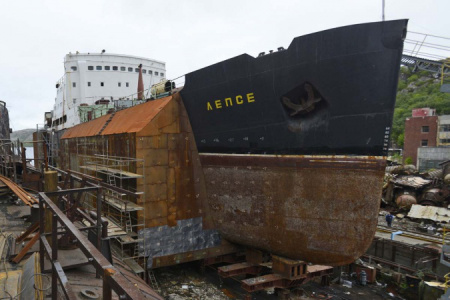Russia: The Lepse service vessel, Russia’s waterborne atomic graveyard, has inched a step closer to complete dismantlement as officials say they will begin extracting nuclear fuel rods from its irradiated holds in September 2018 — a long awaited development involving robotic technology, thousands of technicians and a small city of radiation shelters surrounding the vessel’s hull.
The vessel, which technicians are carefully pulling apart at the Nerpa Shipyard near Murmansk, was used to refuel Russia’s nuclear icebreakers at sea – a job that eventually turned it into one of the world’s most dangerous radioactive hazards. Since its retirement, it has become a flagstone in Northwest Russia’s legacy of Cold War nuclear waste.
Removing spent fuel from the vessel – including the extraction of several damaged assemblies – is among the most complex nuclear cleanup operations Russia has ever undertaken. When it’s completed in 2020, it will be a decades-long culmination of high-tech preparation paid for by marshaling millions of dollars from nearly a dozen western countries, (the European Bank of Reconstruction and Development) often in the face of trying political circumstances.
The new phase in the Lepse dismantlement also marks another step toward cleaning up naval and civilian nuclear debris in Northwest Russia. Almost exactly a year ago, the first containers of spent nuclear fuel that accrued over fifty years at Andreyeva Bay were hauled away for storage. Both are projects that Bellona has long advocated for.
During its career, the Lepse amassed 639 spent nuclear fuel assemblies in its holds, many from refueling the Lenin, the flagship Soviet icebreaker, between 1965 and 1967. The bulk of those fuel rods are damaged, and defy removal by conventional means.
Excerpts from Charles Digges, Anna Kireeva, Russia to start breaking down one of its most radioactive ships next month, Bellona. org, Aug. 1, 2018
